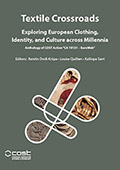Center, Textile Research

Textile Crossroads: Exploring European Clothing, Identity, and Culture across Millennia
Date of this Version
2024
Document Type
Article
Citation
In Textile Crossroads: Exploring European Clothing, Identity, and Culture across Millennia. Anthology of COST Action “CA 19131 – EuroWeb”. Kerstin Droß-Krüpe, Louise Quillien, & Kalliope Sarri, Editors. Zea Books, Lincoln, Nebraska, 2024. DOI: 10.32873/unl.dc.zea.1804
Abstract
Textiles are particularly complex and labor-intensive structures, thus their constructive elements, such as fibers and yarns, as well as the final textile products (e.g., threads, cords, fabrics, and applied decoration) reveal a range of important technical, technological, and sociocultural information. In this paper, we discuss the analysis of excavated textiles at two levels:
1) Technical analysis that offers basic information about the qualities of examined textile samples.
2) Technological analysis that provides insights into technology, social relations of production, and the level of craft specialization or production modes.
Both analyses offer new evidence for environmental resources, sustainability, trade, and exchange, as well as transfer of technical knowledge, innovations, and expertise. Yet, excavated textiles, being formed of organic materials, survive poorly in archaeological contexts and thus represent environmentally limited remnants of the original pattern of textile consumption. Additionally, excavated textiles are often recovered in minute fragments, altered due to post-depositional processes and, therefore, their analysis is usually challenging.
The scope of this paper is to provide an account of the current state of the technological analysis of excavated textiles looking back at its origins, and to offer a concise and clarified synopsis of the main methods and terms used to study and document the technological characteristics of excavated textiles.
Included in
Ancient History, Greek and Roman through Late Antiquity Commons, Archaeological Anthropology Commons, Classical Archaeology and Art History Commons, Classical Literature and Philology Commons, Eastern European Studies Commons, European History Commons, European Languages and Societies Commons, Fiber, Textile, and Weaving Arts Commons, History of Science, Technology, and Medicine Commons, Human Geography Commons, Museum Studies Commons, Place and Environment Commons, Social and Cultural Anthropology Commons, Women's Studies Commons


Comments
Copyright © 2024 by the authors.